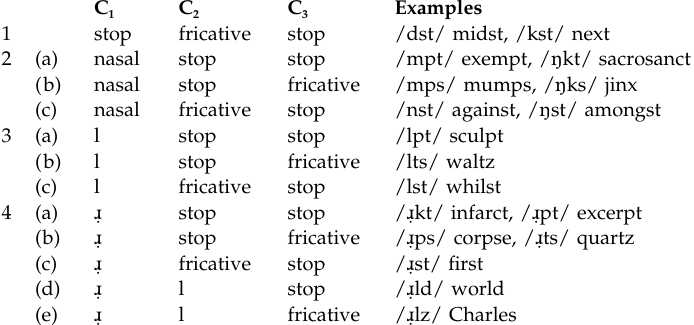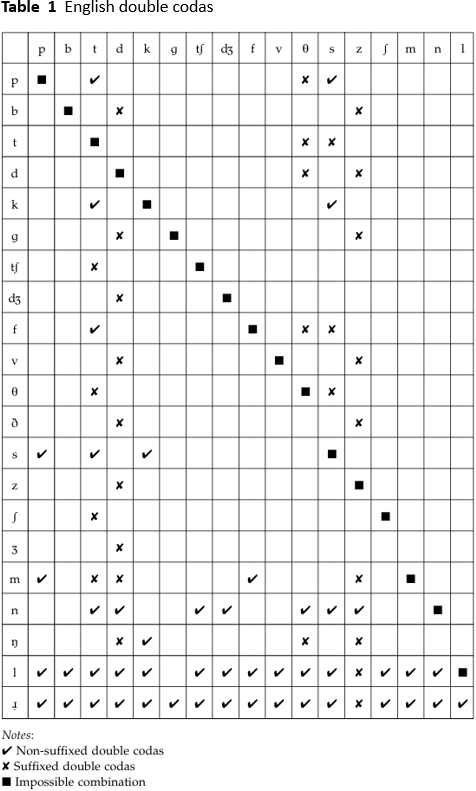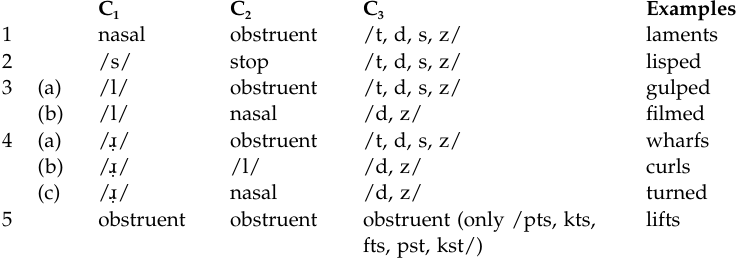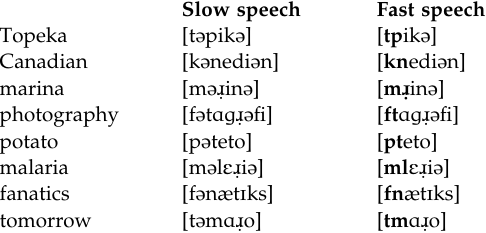


 Grammar
Grammar
 Tenses
Tenses
 Present
Present
 Past
Past
 Future
Future
 Parts Of Speech
Parts Of Speech
 Nouns
Nouns
 Verbs
Verbs
 Adverbs
Adverbs
 Adjectives
Adjectives
 Pronouns
Pronouns
 Pre Position
Pre Position
 Preposition by function
Preposition by function 
 Preposition by construction
Preposition by construction
 Conjunctions
Conjunctions
 Interjections
Interjections
 Grammar Rules
Grammar Rules
 Linguistics
Linguistics
 Semantics
Semantics
 Pragmatics
Pragmatics
 Reading Comprehension
Reading Comprehension|
Read More
Date: 2024-05-04
Date: 22-2-2022
Date: 2024-05-08
|
Triple codas
The triple codas of English do not lend themselves to the rather simple formula we gave for triple onsets. We can say, in more general terms, that with the exception of (1), below, which has three obstruents, all the other combinations consist of a liquid or a nasal (sonorant) followed by two voiceless obstruents. The following combinations are found in non-suffixed forms:


We have to acknowledge the fact that midst in (1), against in (2c), and whilst in (3c) are controversial and may be included in the suffixed category, as we encounter in some publications. Exactly how relevant the historical reasons for this are (midst as the superlative form of mid) for the synchronic (i.e. present day) description of English is very debatable.
In addition to these, a multiplicity of other triple codas is created via suffixation, the great majority of which are provided by /t, d/ of the simple past tense and by /s, z/ of the plural, the possessive, and the third person singular of the simple present. Also noteworthy are the possibilities created by /θ/, the ‘ordinal number morpheme’ (e.g. sixth[sɪksθ]) and the ending deriving nouns from adjectives (denominal morpheme) (e.g. warmth[wɔɹ̣mθ]). The following list gives the possibilities of triple codas via suffixation in terms of general classes; thus, actually occurring clusters have many more combinations than the examples cited here:

It is important to point out that while nasals and liquids serve frequently as C1 in triple codas, and the sequences of /lk, mp, sk/ freely occur as double codas in English, triple codas combining these elements are very restricted. Thus, it is a noteworthy fact that English lacks / ɹ̣lk, ɹ̣mp, ɹ̣sk, lmp, nsk/ as triple codas. Like double codas, clusters of obstruents in triple codas always agree in voicing (e.g. /spt/ lisped).
Before we leave this section, it is appropriate to point out some modifications that are commonly observed with respect to deletions in final clusters. When the word ending in a cluster is followed by a word that begins with a consonant, the final member of the cluster is deleted, as shown below:

This pattern repeats itself in words with suffixes and in compounds, as in the following:

However, if clusters are created by the addition of grammatical endings, this simplification is much less likely, if at all, to occur. Thus, we normally get the following non-reduced forms:

|
|
|
|
4 أسباب تجعلك تضيف الزنجبيل إلى طعامك.. تعرف عليها
|
|
|
|
|
|
|
الفلبين.. بركان "كانلاون" يطلق عمودا من الرماد بارتفاع 4 كم
|
|
|
|
|
|
|
أصواتٌ قرآنية واعدة .. أكثر من 80 برعماً يشارك في المحفل القرآني الرمضاني بالصحن الحيدري الشريف
|
|
|